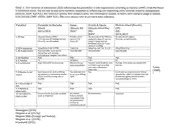
The Socio-ecological system of selected Brazilian small-scale fisheries PDF
Preview The Socio-ecological system of selected Brazilian small-scale fisheries
Table 1. Ten variables of subsystems (SES) influencing the probability of self-organization according to Ostrom (2009) (from Northeast to Southeast coast). The ten key second level variables identified as influencing self-organizing users towards resource management (Ostrom, 2009: 420-421). RS= resource system, RU= resource units, GS= Governance system, U=Users, SES= Social Ecological System, from Ostrom (2007: 15183; 2009: 421). The years shown refer to period of data collection. Variables Fernando de Noronha Itaipu Grande & Gipoia Ilhabela Island (Bonete) Island (Niteroi, RJ) (Grande Island Bay (SP) 2015/2016 20023 (RJ) 200 20095 2014/2015 1. RS Size Annual: 62tons (1998) 1 Number of fish The diversity of the fisheries No data annual capture 1.551 kg total 50 landings (2016)2 species (142 comprises about 42 species, Diversity: no information. Diversity: no information trips): 42 being 11 target species. Estimated catch (167 trips cited) of 12,399kg 2. RS Productivity 32kg/fisher/trip1 (1998) 15kg/trip 44kg/trip, coef. Var. is 2,22. 25kg/fisher/trip 6 3. RS Predictability Unpredictable; some species Unpredictable Unpredictable unpredictable decreasing, such as pargo (schoolmaster snapper) and others 4. RU Mobility High High High High 5. U Number 75 44 fishers 218 60 6. U Leadership High, favored by local economy Relative strong Relative: some localities, such Average, a few action associated with local associations as Provet’a and Aracatiba tourism with more enthusiastic 1Lessa leadership. (1988) 7. U Norms; Social Local rules occur, such as fishing Yes, informal rules Yes Local rules are represented by fishing 2 capital agreements, co-monitoring, among to access to fishing agreements, collective hunting sites and others. Local knowledge also is spots monitoring against outside hunters. visisble. Local knowledge is visible. 8. U Knowledge of High High High High SES 9. U Resource High High High High importance 10. GS collective- Occurred in the past, but currently Not known No information. Inexistent choice rules weak or inexistent. Fishers avoided impositions from the government, such as an extractive reserve4 Domingues (2016). 3Begossi et al. (2013a) 4Begossi 2006 (Ecology and Society) 5Begossi et al. (2013b) 6 Cantareli (2015)
